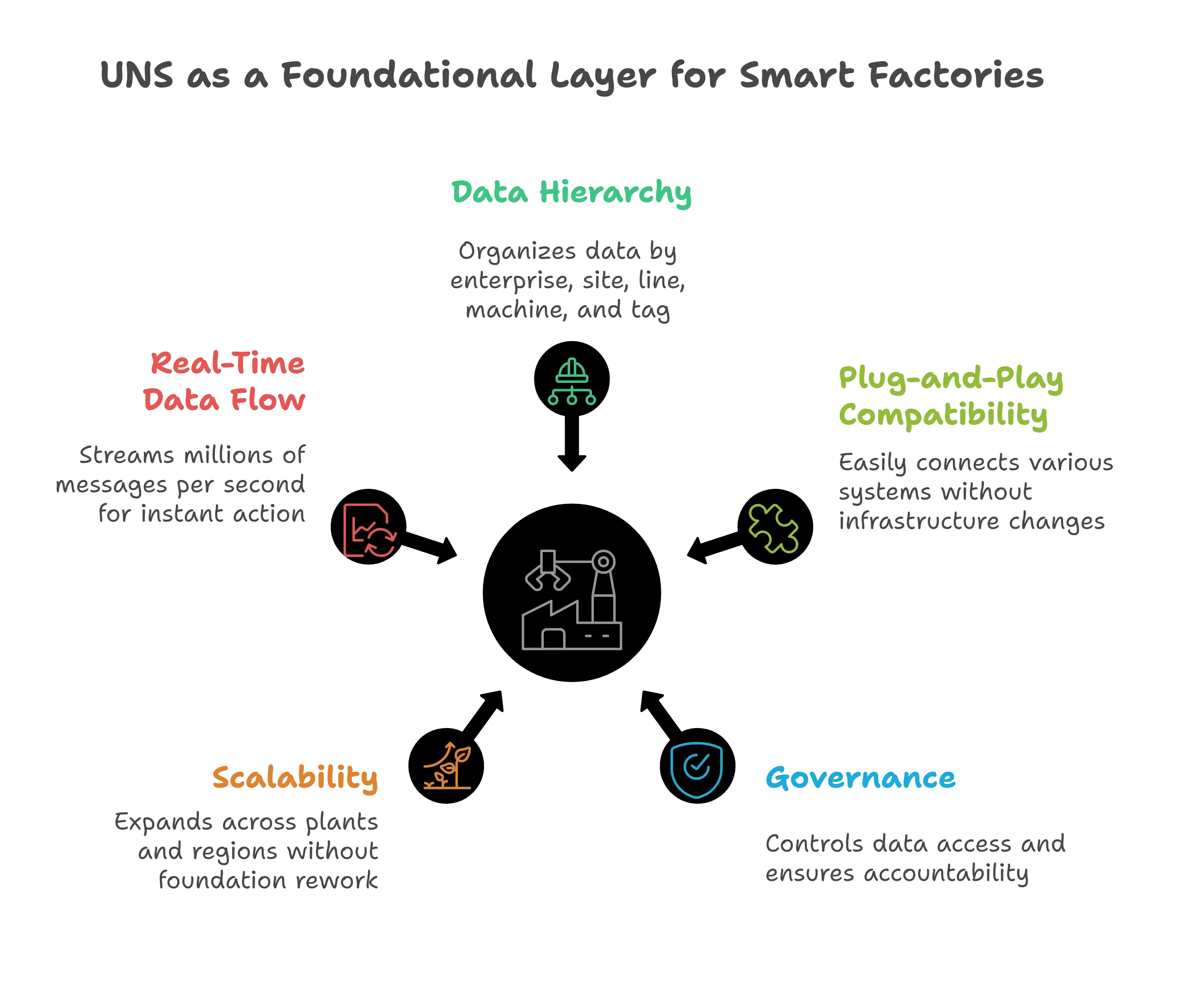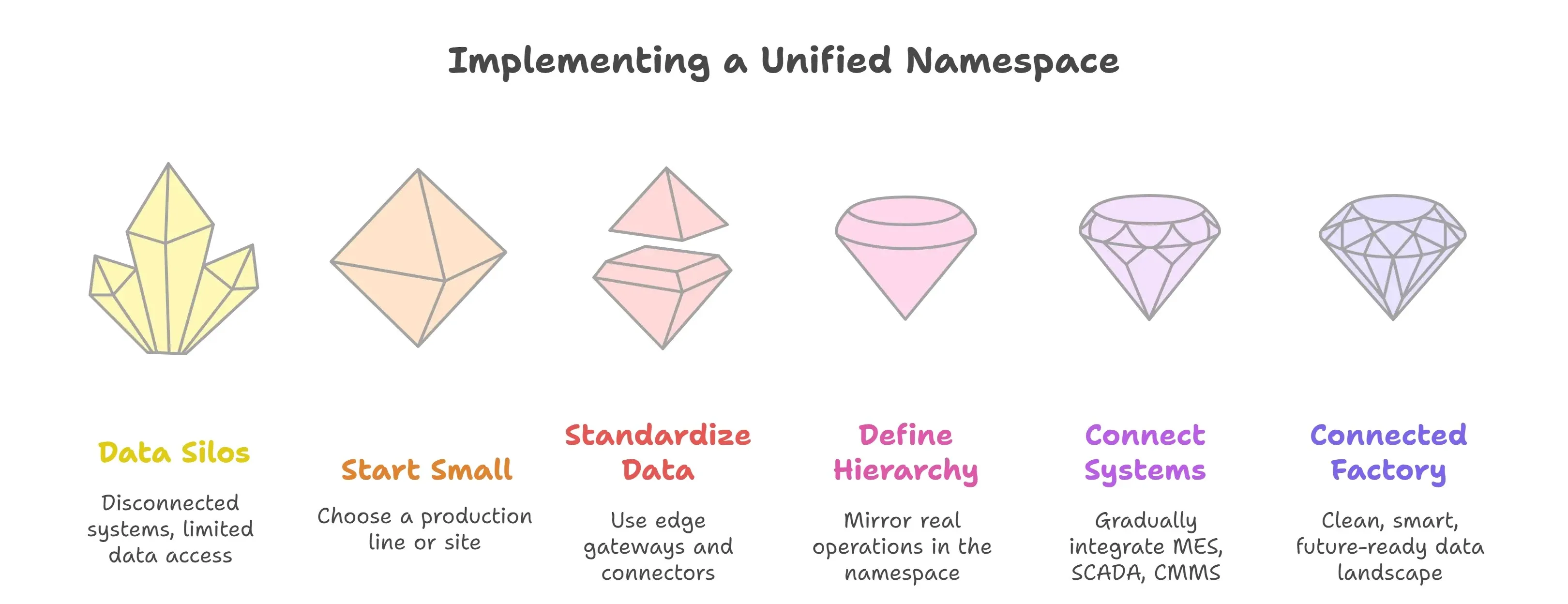What is Unified Namespace?
A Unified Namespace (UNS) is your factory’s single source of truth. It brings all your industrial data—whether it’s coming from machines, sensors, systems, or software—into one place, in real time. Think of it as the digital nervous system of your operations. Just like your brain processes signals from your senses to make decisions, UNS collects and organizes data so your business systems can act intelligently and instantly.
Instead of jumping between tools, waiting on reports, or manually stitching data together, a UNS provides one clean, structured, and real-time view of everything happening on your shop floor and beyond. It’s not just a buzzword—it’s a smarter way to manage and move data. By making real-time information accessible across departments, UNS empowers cross-functional teams to collaborate more effectively, avoid blind spots, and reduce downtime.
Bridging OT and IT in real time
Unified Namespace brings IT and OT together by making data accessible, consistent, and real-time. It uses modern communication standards like MQTT for lightweight messaging, OPC UA for interoperability, and Sparkplug B for context-rich data modeling. These standards are open, vendor-agnostic, and widely adopted across industries.
The result is a flexible, future-proof architecture that allows data to move from machines on the floor to cloud platforms and analytics tools in milliseconds. Operators, engineers, data scientists, and business leaders can all work from the same source of truth—without needing to rely on outdated reports or disconnected systems.
This isn't just about speed. It's about clarity. A well-structured UNS helps everyone—from operators on the floor to executives in the boardroom—see the same data, at the same time, in the same format. That means faster decisions, fewer surprises, and better alignment between operations and business goals.

What makes UNS powerful
UNS isn’t just another integration tool—it’s a foundational layer for building smart factories. Here’s what sets it apart:
- Clear data hierarchy: Your data is organized by enterprise, site, line, machine, and tag—so you always know where it came from. This makes troubleshooting easier and enables standardized reporting across plants.
- Plug-and-play compatibility: Easily connect systems like SCADA, MES, ERP, QMS, and IoT platforms. You don’t need to rip and replace existing infrastructure—UNS works with what you already have.
- Governance built-in: Control who can access, modify, or view different parts of your data model. This helps protect data integrity and ensures accountability.
- High scalability: Start small and expand across plants, regions, and continents without reworking your foundation. Whether you're operating a single site or a global network, UNS scales with you.
- Real-time data flow: Millions of messages per second can be streamed, monitored, and acted on instantly. This enables use cases like predictive maintenance, anomaly detection, and energy optimization.
By offering structure, visibility, and flexibility, UNS turns raw industrial data into an engine for continuous improvement.

How it works in the real world
Imagine a global beverage company with 20 plants—some modern, some built decades ago. Different machines, different systems, different teams. Before UNS, consolidating data for analytics took months. Now, all their plant data—legacy or new—streams into a unified structure.
They use edge devices to collect data from Siemens and Allen Bradley PLCs, connect it to their UNS, and visualize it through dashboards and analytics tools like Databricks. With one common data layer, their quality, maintenance, and production teams are now aligned and proactive.
They’ve eliminated redundant data pipelines, accelerated reporting cycles, and improved OEE across sites. Instead of building custom integrations for each plant, they’ve standardized how data is collected, structured, and consumed. Now, any new plant they onboard follows the same blueprint—with zero delays.
This is the kind of transformation that’s not only possible—but already happening in forward-thinking factories.
Getting started with UNS
The good news is you don’t need to reinvent your factory to implement a UNS. Start small. Choose one production line or one site. Use edge gateways or connectors to bring machine data into a standard structure. Define a hierarchy that mirrors your real operations—enterprise, site, line, machine, tag.
Make sure you use scalable tools like MQTT and Sparkplug B. Choose an MQTT broker that’s enterprise-grade. Then gradually connect other systems—MES, SCADA, CMMS, and so on—to the namespace.
Start by identifying pain points in data access, reporting, or system integration. Use those as your launchpad. Build your UNS to solve specific problems first, then expand its scope once the foundation is proven. With each new connection, your data landscape becomes cleaner, smarter, and more future-ready.
It’s a journey, not a big bang. But every step moves you closer to a smarter, more connected factory.

Final thoughts
Unified Namespace is more than just a technical concept—it’s the foundation for smart manufacturing. It helps factories move faster, respond smarter, and innovate at scale. If you’re serious about Industry 4.0, predictive analytics, or AI-driven decision-making, UNS isn’t optional. It’s essential.
UNS empowers everyone—from OT engineers to data analysts—to work from a unified digital language. It lays the groundwork for digital twins, machine learning, and autonomous operations. And most importantly, it gives manufacturers back control over their most valuable asset: their data.
Want to see what this looks like in your own operations? Let’s talk. We’d love to show you how a Unified Namespace can simplify your data, streamline your systems, and power your next stage of growth.
